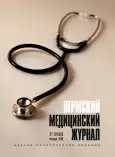Electrocardiographic and cardiobiochemical reactions in patients with closed chest injury
- Authors: Vakhrushev D.S.1
-
Affiliations:
- Izhevsk State Medical Academy
- Issue: Vol 39, No 3 (2022)
- Pages: 34-40
- Section: Original studies
- URL: https://journals.rcsi.science/PMJ/article/view/109330
- DOI: https://doi.org/10.17816/pmj39334-40
- ID: 109330
Cite item
Full Text
Abstract
Objective. To study the electrophysiological and clinicobiochemical characteristics of cardiovascular system in closed injury of the chest.
Materials and methods. There were examined 114 persons diagnosed the closed chest injury, who were admitted to the Thoracic Unit of City Clinical Hospital №9 in Izhevsk. The causes and mechanisms of injuries, the data of clinical and functional methods of investigations of cardiovascular system, the data of case histories and previous preventive examinations were analyzed. The comparison group involved 50 practically healthy men.
Results. The mean age of the persons in the main group and the comparison group was 45.9 ± 12.8 years and 44.7 ± 11.5 years, respectively. The prevailing causes of injury were the following: road accident – 17 persons (14.9 %), fall from a height (higher than one’s own height) – 32 persons (28.0 %), fall from a height of one’s own height – 37 persons (32.5 %). The increased values of the markers of myocardium damages and inflammatory reaction as well as the changes in electrocardiographic parameters were established among the examined persons.
Conclusions. The closed chest injury occurs mainly in the able-bodied population that, of course, is an actual factor for a possible unfavorable labour prognosis. When analyzing the ECG parameters and cardiometabolic characteristics, there were detected the deviations earlier absent in these patients and in patients of the comparison group, which showed the myocardial damage.
Full Text
##article.viewOnOriginalSite##About the authors
D. S. Vakhrushev
Izhevsk State Medical Academy
Author for correspondence.
Email: vds11.92@mail.ru
postgraduate student, Department of General Medical Practice and Internal Diseases with Course of Emergency of Advanced Training Faculty and Occupational Training
Russian Federation, IzhevskReferences
- Akhtamov D.A., Aminov U.Kh., Karabaev Kh.K. i dr. Closed chest injury. Vestnik vracha obshchey praktiki 2004; 4: 28–30 (in Russian).
- Bagnenko S.F., Tulupov A.N. Actual problems of diagnosis and treatment of severe closed chest trauma. Skoraya meditsinskaya pomoshch' 2009; 10 (2): 4–10 (in Russian).
- Tulupov A.N., Shapot Yu.B. Classification of mechanical damage to the chest. Vestnik khirurgii 2007; 1: 21–22 (in Russian).
- Choudhury L., Marsh J.D. Myocardial infarction in young patients. Am. J. Med. 1999; 107: 254–61.
- Marcolini E.G., Keegan J. Blunt Cardiac Injury. Emerg. Med. Clin. North Am. 2015; 33 (3): 519–27.
- Huis In 't Veld M.A., Craft C.A., Hood R.E. Blunt Cardiac Trauma Review. Cardiol. Clin. 2018; 36 (1): 183–191.
- Yousef R., Carr J.A. Blunt cardiac trauma: a review of the currentknowledge and management. Ann Thorac Surg. 2014; 98: 1134–40.
- El-Chami M.F., Nicholson W., Helmy T. Blunt cardiac trauma. J. Emerg. Med. 2008; 35: 127–133.
- Mattox K.L., Flint L.M., Carrico C.J., Grover F., Meredith J., Morris J., Rice C., Richardson D., Rodriquez A., Trunkey D.D. Blunt cardiac injury. J Trauma. 1992; 33 (5): 649–650.
- Shchetkina I.N. Predicting the outcome of closed and isolated and combined chest injury: avtoref. dis. … kand. med. nauk. Perm' 2001; 22 (in Russian).
- Teixeira P.G., Georgiou C., Inaba K. et al. Blunt cardiac trauma: lessonslearned from the medical examiner. J. Trauma 2009; 67: 1259–1264.
- Skinner D.L., Laing G.L., Rodseth R.N., Ryan L., Hardcastle T.C., Muckart D.J. Blunt cardiac injury in critically ill trauma patients: a single centre experience. Injury 2015; 46 (1): 66–70.
- Tactics of the local general practitioner: prakticheskoe rukovodstvo: dlya vrachey-terapevtov uchastkovykh, vrachey obshchey praktiki, klinicheskikh ordinatorov i studentov starshikh kursov meditsinskikh vuzov. Pod red. A.I. Martynova. 2-e izd., pererab. i dop. Moscow: GEOTAR-Media 2021; 299 (in Russian).
- Galin P.Yu., Sermyagin D.V. Electrical instability of the myocardium in patients with myocardial infarction and its prognostic information value. Rossiyskiy kardiologicheskiy zhurnal 2016; (8): 26–30 (in Russian).
- Osipova I.V., Antropova O.N., Shakhmatova K.I., Kondakov V.D. Electrical instability of the myocardium in young men with arterial hypertension and occupational stress. Rossiyskiy kardiologicheskiy zhurnal 2014; (8): 73–76 (in Russian).
Supplementary files






